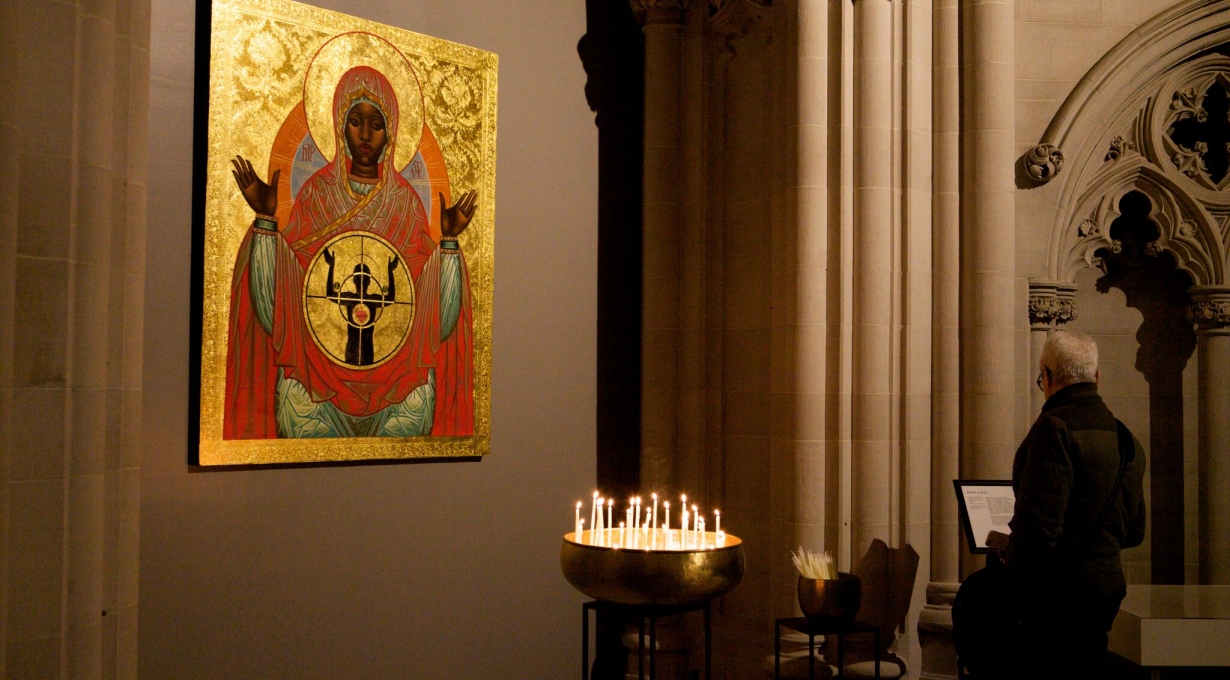Prophesy to the Breath

Photo: Our Lady of Ferguson by Mark Dukes on view in the Cathedral in 2019.
Over the past several days, the city- and nationwide protests against police brutality, specifically the killings of George Floyd, Breonna Taylor, Tony McDade, and countless other Black people by the police, have sparked conversation and reflection by many in the Cathedral community, including our Congregation of St. Saviour, which has issued the following message.
“Prophesy to the breath; prophesy human one! Say to the breath, The Lord God proclaims: Come from the four winds, breath! Breathe into these dead bodies and let them live.” -- Ezekiel 37:9
As George Floyd lay dying, pinned by a police officer’s knee on his neck, bystanders implored the officers, “Let him breathe.”
Breonna Taylor, an EMT who hoped to become a nurse, breathed life into others, but like George Floyd, she too had her breath and life stolen away.
These sins cannot be blamed on only one group of malfeasants. It isn’t just what police did, but also what doctors didn’t do. In April of this year, what seems like almost a lifetime ago, Jason Hargrove—an essential worker and the former president of the Detroit bus drivers’ union—went to the hospital clamoring for help. He had COVID-19 symptoms, he had trouble breathing, but like too many Black and brown people, his distress was not believed. Three days later, his breath, too, had been taken from him.
Did these people not have a right to the breath of life?
As we affirm our faith, we assert their God-given right to live. The philosopher and humanist Franz Fanon observed, “When we revolt,” we do it “simply because, for many reasons, we can no longer breathe.” The disparity in treatment—by police, by medical practitioners, by banks, by the whole structure of American life—that Black and brown people face relative to our white fellows takes our breath away. These three individuals, and their shocking and avoidable deaths, are only the latest names added to a tortuously long legacy.
These differences in treatment, even to the point of death, have spawned so many breathtaking examples. Consider how American police have responded with violence to Black and brown people for not practicing social distancing in their communities, then offered only weak admonishments and advice to white bodies at leisure. Consider why kneeling on a football field is demonized, but carrying guns into a statehouse is considered an understandable expression of rage for those who feel that their liberties have been denied. These injustices and hypocrisies are patterned by race—what we call structural racism—and they emerge from a long history of racial terror and anti-Black rules and regulations that have enabled this terror to thrive.
As people of faith, we call on police officers and others who find these acts of racism deplorable to kneel in prayer, to ask forgiveness for what they have done and what they have left undone.
We call on police chiefs across the country to end the predictive policing that targets Black and brown communities, and to instead scrutinize the danger that dwells within their own ranks. We call on them to turn their focus from using Big Data solely to surveil our communities, and instead use these tools to pinpoint which officers are a danger to the very civilians they are pledged to serve.
We call on our healthcare leaders to insist that medical providers understand and believe the communities they serve—that they learn to see, acknowledge, and believe Black pain and to treat it without delay.
We call on hospital administrators to track and publicly release data by race, so that we may have a clearer picture and accurate statistics showing who gets treated more quickly and effectively, versus who is sent home prematurely, even to their deaths.
We call on the people of New York City, and people across the country, to speak their truth and join together against structural racism, its perversity and violence.
As a community, we commit ourselves to use the Cathedral’s convening authority to bring together those families in our Diocese affected by police brutality face-to-face with the officers who feel called to help repair the breach.
While we need large-scale structural changes to ensure justice for all, we cannot wait to comfort and to save. On Monday, we saw President Trump order the use of tear gas, rubber bullets, and concussion grenades in front of Saint John’s Episcopal Church in Washington, DC, where our clergy, Black Lives Matter medics, and peaceful protestors gathered in respite and prayer. We saw President Trump carry, but not open, the Bible. He stood to pose, when he should have kneeled to pray.
Our clergy and those with whom they minister understand that the time to act is now. And we will continue to act, to kneel in prayer and humility, to help our community draw breath and thrive, long after the cameras have gone away.
The Rt. Rev. Clifton Daniel, III
Dean, The Cathedral Church of Saint John the Divine
The Rev. Canon Patrick Malloy
Sub Dean, The Cathedral Church of Saint John the Divine
The Rev. Canon Steven Lee
Vicar, The Cathedral Congregation of Saint Saviour
Marsha Ra
Senior Warden, The Cathedral Congregation of Saint Saviour
Timothy Dwyer
Junior Warden, The Cathedral Congregation of Saint Saviour